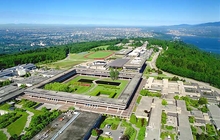Projects
Handover mechanism of mobile WiMAX (802.16E) with Wi-Fi (802.11g) technology
 IEEE802.16e (Mobile WiMAX) standard is proposed to support mobility, handover has
become one of the most important Quality of Service (QoS) factors. Applications
like mobile Voice over Internet Protocol (VoIP), multimedia gaming greatly benefits
from low-latency. To maintain such low-latency and keeping high QoS various advanced
handover schemes are being proposed and developed. The hybrid networks of Wi-Fi
and WiMAX can provide high data rate and enhanced multimedia services, but it is
challenging to obtain optimized handover decision based dynamic QoS information.
IEEE802.16e (Mobile WiMAX) standard is proposed to support mobility, handover has
become one of the most important Quality of Service (QoS) factors. Applications
like mobile Voice over Internet Protocol (VoIP), multimedia gaming greatly benefits
from low-latency. To maintain such low-latency and keeping high QoS various advanced
handover schemes are being proposed and developed. The hybrid networks of Wi-Fi
and WiMAX can provide high data rate and enhanced multimedia services, but it is
challenging to obtain optimized handover decision based dynamic QoS information.
The first goal of this project is to implement various techniques used for handover in mobile Wimax technology and compare the performance of such techniques in different physical channel environment. The second stage of this project is to implement and simulate the handover techniques from WiMax to WiFi without degradation in the QoS i.e. maintaining the connectivity of the MS (mobile station) to either base station.
The third stage is the coordination of both technologies at the same time i.e. keeping the MS (mobile station) connected to both technologies so that the SS (subscriber station) feels the huge bandwidth available when both technologies are simultaneously available. We will divide this project into 3 phases so we can build and model our system in the right way for easy debugging. However, our first goal is to accomplish the first stage, and as time permits we will continue the other phases. We intend to complete our model with a full documentation as an open source for interested students.

[1] B. G. Lee and S. Choi, Broadband Wireless Access and Local Networks Mobile WiMAX and WiFi. ARTECH HOUSE, INC,2008.
[2] H. Pirkomaji and V. Vakily, “Improved handover interruption time in wimax, using gps,” in Next Generation Mobile Applications,Services and Technologies (NGMAST), 2010 Fourth International Conference on, 2010, pp. 203 –207.
[3] B.-G. Choi, K. P. Moon, Y. M. Kwon, and M. Y. Chung, “An inter-fa handover scheme to improve performance of mobile wimax systems,” in TENCON 2009 - 2009 IEEE Region 10 Conference, Jan. 2009, pp. 1 –5.
[4] S. Choi, G.-H. Hwang, T. Kwon, A.-R. Lim, and D.-H. Cho, “Fast handover scheme for real-time downlink services in ieee 802.16e bwa system,” in Vehicular Technology Conference, 2005.VTC 2005-Spring. 2005 IEEE 61st, vol. 3, June 2005, pp. 2028– 2032.
[5] R. Rouil and N. Golmie, “Adaptive channel scanning for ieee 802.16e,” in Military Communications Conference, 2006. MILCOM 2006. IEEE, 2006, pp. 1 –6.
[6] “Approved draft ieee standard for local and metropolitan area networks corrigendum to ieee standard for local and metropolitan area networks-part 16: Air interface for fixed broadband wireless access systems (incorporated into ieee std 802.16e-2005 and ieee std 802.16-2004/cor 1-2005 e),” IEEE Std P802.16/Cor1/D5, 2005.
[7] “Ieee standard for local and metropolitan area networks part 16: Air interface for broadband wireless access systems,” IEEE Std 802.16-2009 (Revision of IEEE Std 802.16-2004), pp. C1 –2004, 29 2009.
[8] N. Riato, S. Sorrentino, D. Franco, C. Masseroni, M. Rastelli, and R. Trivisonno, “Impact of mobility on physical and mac layer algorithms performance in wimax system,” in Personal, Indoor and Mobile Radio Communications, 2007. PIMRC 2007. IEEE 18th International Symposium on, 2007, pp.1 –6.
[9] W. Zhang, J. Jaehnert, and K. Dolzer, “Design and evaluation of a handover decision strategy for 4th generation mobile networks,” in Vehicular Technology Conference, 2003. VTC 2003-Spring. The 57th IEEE Semiannual, vol. 3, 2003, pp. 1969 – 1973 vol.3.
 A kingdom on the East Bank of the River Jordan. The country borders Saudi Arabia
to the east and south-east, Iraq to the north-east..
A kingdom on the East Bank of the River Jordan. The country borders Saudi Arabia
to the east and south-east, Iraq to the north-east.. Simon Fraser University, commonly referred to as SFU, is a Canadian public research
university in British Columbia with its main campus on Burnaby Mountain in Burnaby..
Simon Fraser University, commonly referred to as SFU, is a Canadian public research
university in British Columbia with its main campus on Burnaby Mountain in Burnaby..